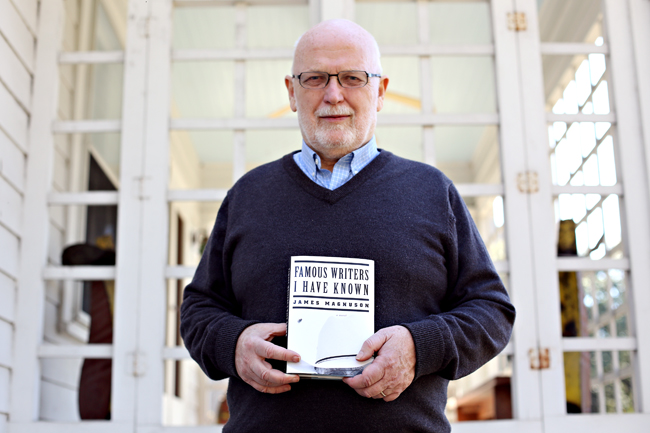For the past 20 years, James Magnuson has been waking up early to write before coming into work as the director of the Michener Center for Writers.
Magnuson’s newest of nine novels, “Famous Writers I Have Known,” gives a satirical look into the workings of the Master-of-Fine-Arts culture. The plot centers on Frankie Abandonato, a con man who pretends to be V. S. Mohle — a resident writer at the Fiction Center, which is based on UT’s Michener center. In the novel, the Fiction Center is funded by author Rex Schoeninger, who is a transparent version of the Michener center’s namesake, James Michener.
UT’s Michener center is a three-year residency program for aspiring writers. Students can apply to concentrate in one of four writing fields: fiction, poetry, screenwriting or playwriting, and receive a $27,500 stipend each year. With an acceptance rate hovering around 1 percent — the center only accepts 12 writers each year — it is recognized as one of the top creative writing programs in the country.
Magnuson came back to Texas and took the director position in 1994 after a stint as a television writer in Hollywood. He said that at first the Michener center job was just a salary to support his writing career, but he began to love his students and care about their careers.
“Teaching has become an important part of my life,” Magnuson said. “You know you start thinking about this when you become an old dog. You start thinking about your legacy. I’m so proud of all of these young writers who have done so well. You know it’s interesting how personal it can be, the idea of creating an institution.”
It is his work directing the Michener center and building its reputation that has allowed him an insider view into the world of MFA students and famous authors. He used these observations as the basis for “Famous Writers I Have Known.”
“I have known Jim Magnuson for a long time,” said Stephen Harrigan, a faculty member at the Michener center. “We are close friends so I read the book in advance years ago, and I thought it was a brilliant and subversive look at his own profession. He knows the world he’s writing about intimately enough to kind of sabotage it in a way.”
“Famous Writers I Have Known” is both a satirical look at the writing world and a recollection of Magnuson’s daily task at the Michener center, one of which is picking up authors at the airport with only a jacket photo as identification. This is how Abandonato’s character was formed.
“I came up with this idea of a con man passing himself off as a writer, writers not being that different anyway in some cases,” Magnuson said. “They are both liars, con men and writers. They are both inventors, and they’re self-invented.”
Michener wrote more than 40 different and popular books throughout his career, but he received little recognition as an author of literary merit. He left all of his money to the University to create the Michener center.
“I think that what [Michener] got really right was the way there is this kind of towering presence that is infused into the life of the program,” former Michener center student Dominic Smith said. “As a student, there was never a time I got a stipend check that I didn’t think, ‘This is coming from the Michener estate.’”
Michener’s life inspired the book’s second plot, as Magnuson was able to observe it first-hand. The two worked together for many years, and Magnuson saw the sadness under Michener’s generous front.
“I knew Michener the last 10 years of his life, and I was very aware of lots of people trying to get a hold of his money in one way or another,” Magnuson said. “He had no children. There was something very painful about it.”
“Famous Writers I Have Known” is a satire, and one of the most obvious objects of satirization is Michener through Shoeinger. Magnuson was careful to show the duality of Michener. While Michener was caring and giving for the most part, he was also troubled and could be somewhat difficult to work with.
“On one hand it is fictionalized,” Magnuson said. “On the other hand, I would say that he wasn’t always easy near the end of his life. He could blow up from time to time. It’s much different having to work for someone as opposed to having them shower you with all this largesse.”
The students and their writing workshops were playfully mocked in the book, but Magnuson said the students are not based on anyone in particular.
“I feel like some of the dialogue in his book came from real classes that I’ve had with him, but students of past years will say the same thing because writing workshops have something kind of repetitive about them,” former Michener center student Domenica Ruta said. “They all fall under similar structures. There are different types and tropes, and [Magnuson] captures them all very well.”
The book’s satire is not hurtful or mean-spirited. Instead, it points out poignant truths about Magnuson’s experiences with the Michener center, and writers in general.
“My feeling is everyone gets dusted up a good amount in the book but everyone gets their dues,” Magnuson said. “There are different kinds of comedy. There is some comedy that really is totally vicious and delightful and there’s other comedy that is a little gentler and warmer. This is not the most savage book. I hope people can be moved by it, and I hope people can laugh.”




















